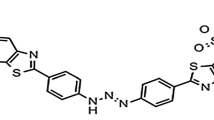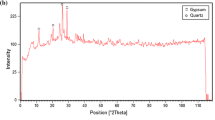Abstract
Local natural clay from Topkhana (Sulaimani district, Kurdistan region of Iraq) was characterized with XRD, XRF, FT-IR, and gas adsorption analyzer. The clay sample was dominated by saponite with minor amounts of chlorite. The clay was examined for its efficiency to adsorb and remove methylene blue (MB) from clinical laboratory wastewater by a batch method. The effects of pH, temperature, clay dosage, and initial MB concentration on the adsorption efficiency were investigated. The equilibrium experimental data were analyzed using Langmuir, Freundlich, Temkin, and Redlich-Peterson (R-P) isotherms. Most of the MB adsorption could be explained by cation exchange. The saponite, therefore, was the most important component in the clay. The rate of the adsorption process was found to follow pseudo-second-order kinetics. The conventional linear least squares method was compared with the more accurate method of non-linear curve fitting for the determination of isotherm and kinetic model parameters. Two error functions (the sum of the squared residuals and the correlation of determination) were used to evaluate the linear and non-linear regression analysis applied to the experimental data. Equilibrium thermodynamic parameters indicated a spontaneous and endothermic adsorption process.
Similar content being viewed by others
References
Pearce CI, Lloyd JR, Guthrie JT (2003) The removal of colour from textile wastewater using whole bacterial cells: a review. Dyes Pigments 58:179–196. https://doi.org/10.1016/S0143-7208(03)00064-0
Robinson T, McMullan G, Marchant R, Nigam P (2001) Remediation of dyes in textile effluent: a critical review on current treatment technologies with a proposed alternative. Bioresour Technol 77:247–255. https://doi.org/10.1016/S0960-8524(00)00080-8
Miclescu A, Wiklund L (2010). Methylene blue , an old drug with new indications ? 17:35–41
Mirrett S, Lauer BA, Miller GA, Reller LB (1982) Orange, Methylene Blue. Cultures 15:562–566
Houas a (2001) Photocatalytic degradation pathway of methylene blue in water. Appl Catal B Environ 31:145–157. https://doi.org/10.1016/S0926-3373(00)00276-9
Lachheb H, Puzenat E, Houas A, Ksibi M, Elaloui E, Guillard C, Herrmann JM (2002) Photocatalytic degradation of various types of dyes (alizarin S, Crocein Orange G, methyl red, Congo red, methylene blue) in water by UV-irradiated titania. Appl Catal B Environ 39:75–90. https://doi.org/10.1016/S0926-3373(02)00078-4
Dutta K, Mukhopadhyay S, Bhattacharjee S, Chaudhuri B (2001) Chemical oxidation of methylene blue using a Fenton-like reaction. J Hazard Mater 84:57–71. https://doi.org/10.1016/S0304-3894(01)00202-3
Deng H, Yang L, Tao G, Dai J (2009) Preparation and characterization of activated carbon from cotton stalk by microwave assisted chemical activation-application in methylene blue adsorption from aqueous solution. J Hazard Mater 166:1514–1521. https://doi.org/10.1016/j.jhazmat.2008.12.080
Yao Y, Xu F, Chen M, Xu Z, Zhu Z (2010) Adsorption behavior of methylene blue on carbon nanotubes. Bioresour Technol 101:3040–3046. https://doi.org/10.1016/j.biortech.2009.12.042
Mak S-Y, Chen D-H (2004) Fast adsorption of methylene blue on polyacrylic acid-bound iron oxide magnetic nanoparticles. Dyes Pigments 61:93–98. https://doi.org/10.1016/j.dyepig.2003.10.008
Hong S, Wen C, He J, Gan F, Ho YS (2009) Adsorption thermodynamics of methylene blue onto bentonite. J Hazard Mater 167:630–633. https://doi.org/10.1016/j.jhazmat.2009.01.014
Almeida CAP, Debacher NA, Downs AJ, Cottet L, Mello CAD (2009) Removal of methylene blue from colored effluents by adsorption on montmorillonite clay. J Colloid Interface Sci 332:46–53. https://doi.org/10.1016/j.jcis.2008.12.012
Bao Y, Zhang G (2012) Energy Procedia Study of Adsorption Characteristics of Methylene Blue onto Activated Carbon Made by Salix Psammophila 16:1141–1146. https://doi.org/10.1016/j.egypro.2012.01.182
Taylor P, Sarma GK, Sengupta S, et al (2011) Separation Science and Technology Methylene Blue Adsorption on Natural and Modified Clays Methylene Blue Adsorption on Natural and Modified Clays. 37–41. https://doi.org/10.1080/01496395.2011.565012
Mukherjee K, Kedia A, Jagajjanani Rao K, Dhir S, Paria S (2015) Adsorption enhancement of methylene blue dye at kaolinite clay-water interface influenced by electrolyte solutions. RSC Adv 5:30654–30659. https://doi.org/10.1039/c5ra03534a
Sreńscek-Nazzal J, Narkiewicz U, Morawski AW, Wróbel RJ, Michalkiewicz B (2015) Comparison of optimized isotherm models and error functions for carbon dioxide adsorption on activated carbon. J Chem Eng Data 60:3148–3158. https://doi.org/10.1021/acs.jced.5b00294
Maataoui YEL, M’rabet MEL, Maaroufi A et al (2017) Adsorption isotherm modeling of carbendazim and flumetsulam onto homoionic-montmorillonite clays: comparison of linear and nonlinear models. Turk J Chem 41:514–524. https://doi.org/10.3906/kim-1612-56
Brown a M (2001) A step-by-step guide to non-linear regression analysis of experimental data using a Microsoft excel spreadsheet. Comput Methods Prog Biomed 65:191–200. https://doi.org/10.1016/S0169-2607(00)00124-3
Dohrmann R, Genske D, Karnland O, Kaufhold S, Kiviranta L, Olsson S, Plötze M, Sandén T, Sellin P, Svensson D, Valter M (2012) Interlaboratory CEC and exchangeable cation study of bentonite buffer materials: I. Cu(II)-triethylenetetramine method. Clay Clay Miner 60:162–175. https://doi.org/10.1346/CCMN.2012.0600206
Arab M, Bougeard D, Smirnov KS (2002) Experimental and computer simulation study of the vibrational spectra of vermiculite. Phys Chem Chem Phys 4:1957–1963. https://doi.org/10.1039/b110768b
Muiambo HF, Focke WW, Atanasova M, der Westhuizen I, Tiedt LR (2010) Thermal properties of sodium-exchanged palabora vermiculite. Appl Clay Sci 50:51–57. https://doi.org/10.1016/j.clay.2010.06.023
Kobayashi I, Owada H, Ishii T, Iizuka A (2017) Evaluation of specific surface area of bentonite-engineered barriers for Kozeny-carman law evaluation of specific surface area of bentonite-engineered barriers. Soils Found 57:683–697. https://doi.org/10.1016/j.sandf.2017.08.001
El Mouzdahir Y, Elmchaouri A, Mahboub R et al (2007) Adsorption of methylene blue from aqueous solutions on a moroccan clay. J Chem Eng Data 52:1621–1625. https://doi.org/10.1021/je700008g
Marzouk MA, El-Kheshen AA, Sayed Ahmed SA, Aboelenin RMM (2018) Spectroscopic studies on Nano-single crystal BiVO4 glass ceramic as dye degradation for wastewater purification. Silicon 10:509–517. https://doi.org/10.1007/s12633-016-9482-0
Jemima WS, Magesan P, Chiranjeevi P, Umapathy MJ (2018) Sorption properties of Organo modified montmorillonite clay for the reclamation of chromium (VI) from waste water. Silicon:1–9. https://doi.org/10.1007/s12633-018-9887-z
Jalil AA, Triwahyono S, Adam SH, Rahim ND, Aziz MAA, Hairom NHH, Razali NAM, Abidin MAZ, Mohamadiah MKA (2010) Adsorption of methyl orange from aqueous solution onto calcined Lapindo volcanic mud. J Hazard Mater 181:755–762. https://doi.org/10.1016/j.jhazmat.2010.05.078
Padmesh TVN, Vijayaraghavan K, Sekaran G, Velan M (2006) Application of two- and three-parameter isotherm models: biosorption of acid red 88 onto Azolla microphylla. Bioremediat J 10:37–44. https://doi.org/10.1080/10889860600842746
Han R, Zhang J, Han P, Wang Y, Zhao Z, Tang M (2009) Study of equilibrium, kinetic and thermodynamic parameters about methylene blue adsorption onto natural zeolite. Chem Eng J 145:496–504. https://doi.org/10.1016/j.cej.2008.05.003
Auta M, Hameed BH (2012) Modified mesoporous clay adsorbent for adsorption isotherm and kinetics of methylene blue. Chem Eng J 198–199:219–227. https://doi.org/10.1016/j.cej.2012.05.075
Hameed BH (2016) Cross-linked chitosan / sepiolite composite for the adsorption of methylene blue and reactive. Int J Biol Macromol 93:1231–1239. https://doi.org/10.1016/j.ijbiomac.2016.09.069
Gürses A, Doǧar Ç, Yalçin M et al (2006) The adsorption kinetics of the cationic dye, methylene blue, onto clay. J Hazard Mater 131:217–228. https://doi.org/10.1016/j.jhazmat.2005.09.036
Cottet L, Almeida CAP, Naidek N, Viante MF, Lopes MC, Debacher NA (2014) Adsorption characteristics of montmorillonite clay modified with iron oxide with respect to methylene blue in aqueous media. Appl Clay Sci 95:25–31. https://doi.org/10.1016/j.clay.2014.03.023
Doǧan M, Özdemir Y, Alkan M (2007) Adsorption kinetics and mechanism of cationic methyl violet and methylene blue dyes onto sepiolite. Dyes Pigments 75:701–713. https://doi.org/10.1016/j.dyepig.2006.07.023
Hamdaoui O (2006) Batch study of liquid-phase adsorption of methylene blue using cedar sawdust and crushed brick. J Hazard Mater 135:264–273. https://doi.org/10.1016/j.jhazmat.2005.11.062
Sakin O, Ali M, Hussein BHM, Mgaidi A (2017) Adsorption thermodynamics of cationic dyes ( methylene blue and crystal violet ) to a natural clay mineral from aqueous solution between 293 and 15. Arab J Chem. https://doi.org/10.1016/j.arabjc.2017.10.007
Elmoubarki R, Mahjoubi FZ, Tounsadi H, Moustadraf J, Abdennouri M, Zouhri A, el Albani A, Barka N (2015) Adsorption of textile dyes on raw and decanted Moroccan clays: kinetics, equilibrium and thermodynamics. Water Resour Ind 9:16–29. https://doi.org/10.1016/j.wri.2014.11.001
Wibulswas R (2004) Batch and fixed bed sorption of methylene blue on precursor and QACs modified montmorillonite. Sep Purif Technol 39:3–12. https://doi.org/10.1016/j.seppur.2003.12.018
Shabani E, Salimi F, Jahangiri A (2018) Removal of arsenic and copper from water solution using magnetic Iron/bentonite nanoparticles (Fe3O4/bentonite). Silicon:1–11. https://doi.org/10.1007/s12633-018-9895-z
Zawrah MF, Sayed E, El Shereefy E, Khudir AY (2018) Reverse precipitation synthesis of ≤ 10 nm magnetite nanoparticles and their application for removal of heavy metals from water. Springer Nat 11:85–104. https://doi.org/10.1007/s12633-018-9841-0
Ho YS, McKay G (2000) The kinetics of sorption of divalent metal ions onto sphagnum moss peat. Water Res 34:735–742. https://doi.org/10.1016/S0043-1354(99)00232-8
Tan IAW, Ahmad AL, Hameed BH (2008) Adsorption of basic dye on high-surface-area activated carbon prepared from coconut husk: equilibrium, kinetic and thermodynamic studies. J Hazard Mater 154:337–346. https://doi.org/10.1016/j.jhazmat.2007.10.031
Zaghouane-Boudiaf H, Boutahala M, Sahnoun S, Tiar C, Gomri F (2014) Adsorption characteristics, isotherm, kinetics, and diffusion of modified natural bentonite for removing the 2,4,5-trichlorophenol. Appl Clay Sci 90:81–87. https://doi.org/10.1016/j.clay.2013.12.030
Doǧan M, Abak H, Alkan M (2009) Adsorption of methylene blue onto hazelnut shell: kinetics, mechanism and activation parameters. J Hazard Mater 164:172–181. https://doi.org/10.1016/j.jhazmat.2008.07.155
Acknowledgements
This study has not been financed by any government or private funding agencies. We gratefully acknowledge Federal Institute for Geosciences and Natural Resources (BGR), for the support and their assistance and all who contributed to conduction of this study.
Author information
Authors and Affiliations
Corresponding author
Additional information
Publisher’s Note
Springer Nature remains neutral with regard to jurisdictional claims in published maps and institutional affiliations.
Rights and permissions
About this article
Cite this article
Salh, D.M., Aziz, B.K. & Kaufhold, S. High Adsorption Efficiency of Topkhana Natural Clay for Methylene Blue from Medical Laboratory Wastewater: a Linear and Nonlinear Regression. Silicon 12, 87–99 (2020). https://doi.org/10.1007/s12633-019-00100-0
Received:
Accepted:
Published:
Issue Date:
DOI: https://doi.org/10.1007/s12633-019-00100-0




